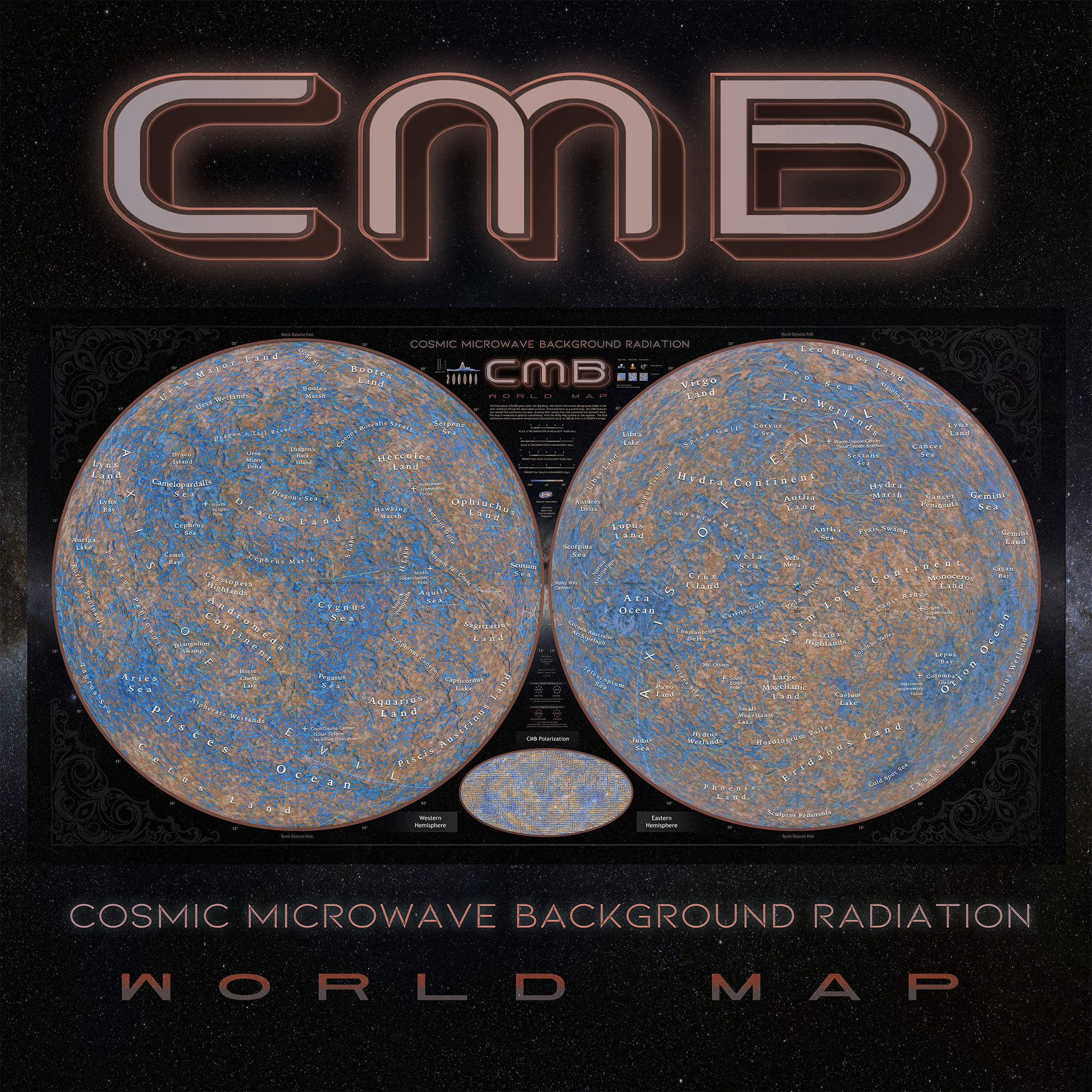Presented here as a World Map, the CMB features are named after continents and seas, with labels drawn from the constellations below. The concave, double-hemisphere map resembles two halves of an empty orange peel. For reference, the Milky Way’s plane runs along the equator, with the center positioned at the heart of the image. The blue and brown colors indicate temperature fluctuations of up to 300 µK around a 2.725 K average. Although these fluctuations are extremely subtle, the most prominent differences occur on a physical scale of about one degree—roughly 1/180th of the sphere’s diameter—appearing as small dots across the full circle. This results in numerous small islands and fragmented bodies of water. While the resemblance to Earth’s oceanic relief is limited, we aimed to create a credible planetary representation.
Data credit ESA and Planck Collaboration. Map idea and realization Pablo C. Budassi in May 2025.

▿ explore and zoom below ▿
maximizing viewer screen is recommended! ☒

The Western Hemisphere of the Cosmic Microwave Background map covers the region defined by galactic coordinates from 0 to 180. This section of the map organizes data from the early universe into distinct, imaginatively named regions—such as various “lands,” “continents,” and “seas”. 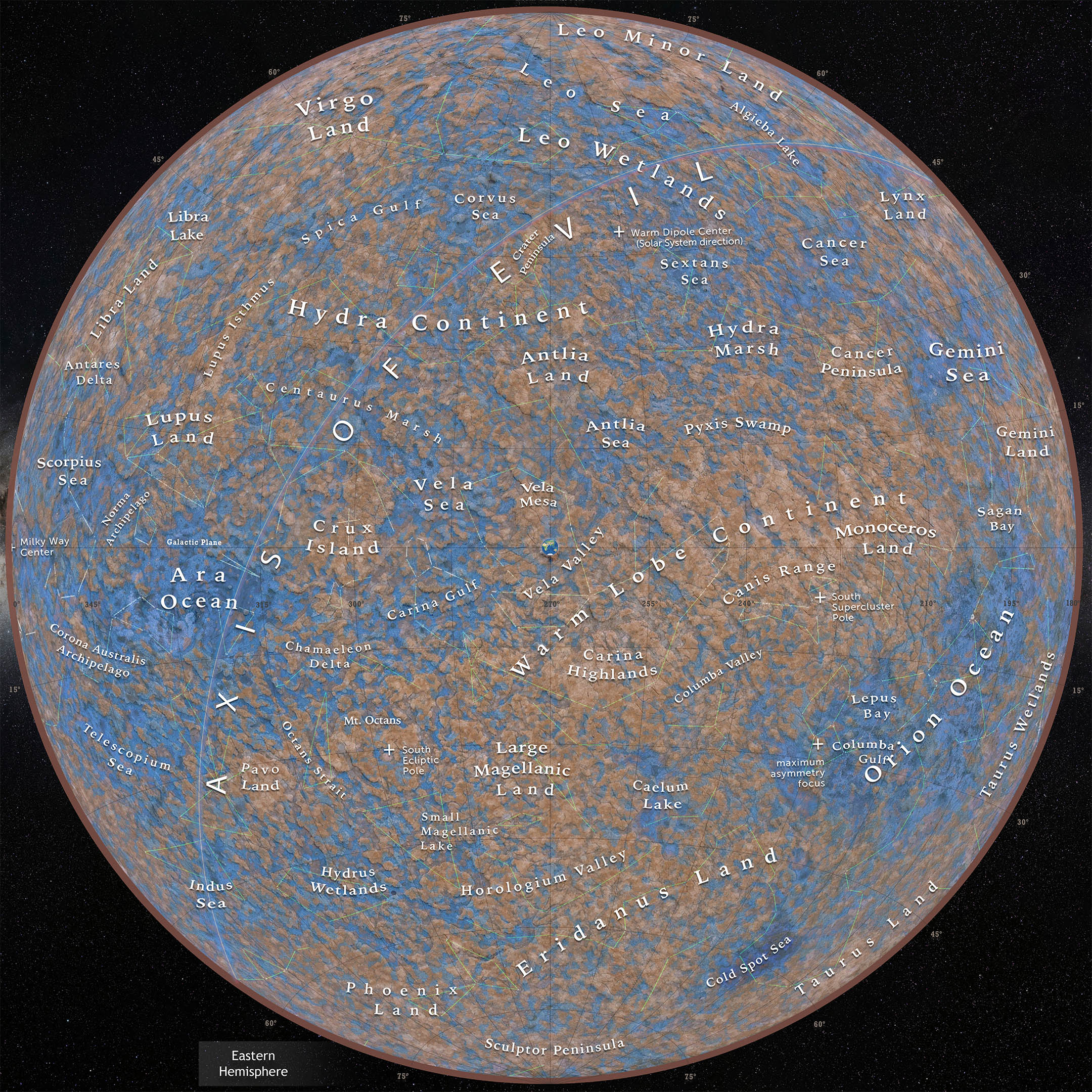
The Eastern Hemisphere, spanning galactic longitudes from 180 to 360 degrees, offers a detailed cartography of regions and features named after constellations and astronomical entities. Notable areas include the Hydra Continent and Eridanus Land, along with bodies of water designated as the Ara and Orion Oceans. Additionally, marked locations like the Warm Dipole Center and South Supercluster Pole serve as reference points for the map’s spatial orientation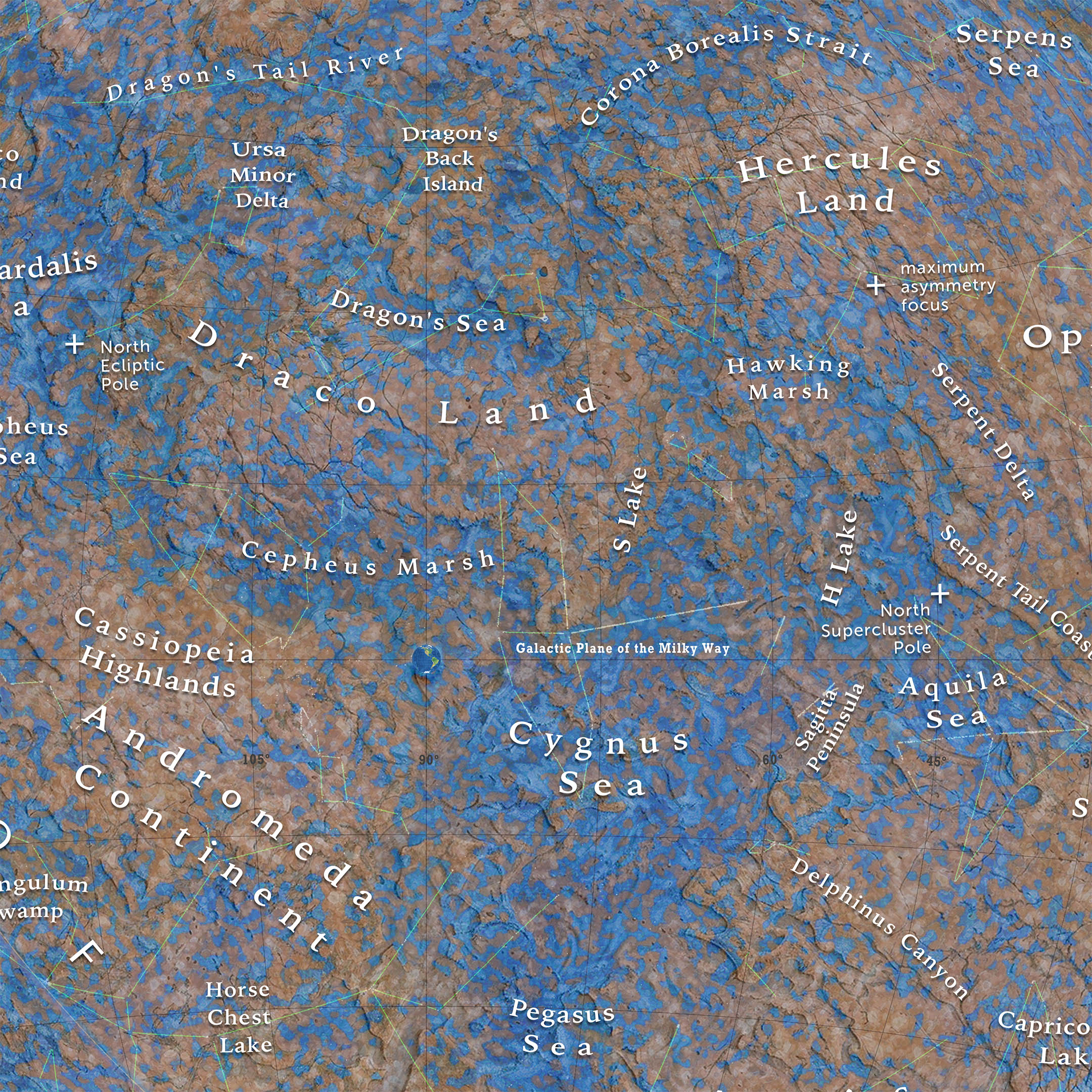 Key regions include Draco and Hercules Land, the Andromeda Continent, along with bodies of water like the Cygnus Sea, and other features such as Cepheus Marsh and Cassiopeia Highlands.
Key regions include Draco and Hercules Land, the Andromeda Continent, along with bodies of water like the Cygnus Sea, and other features such as Cepheus Marsh and Cassiopeia Highlands. 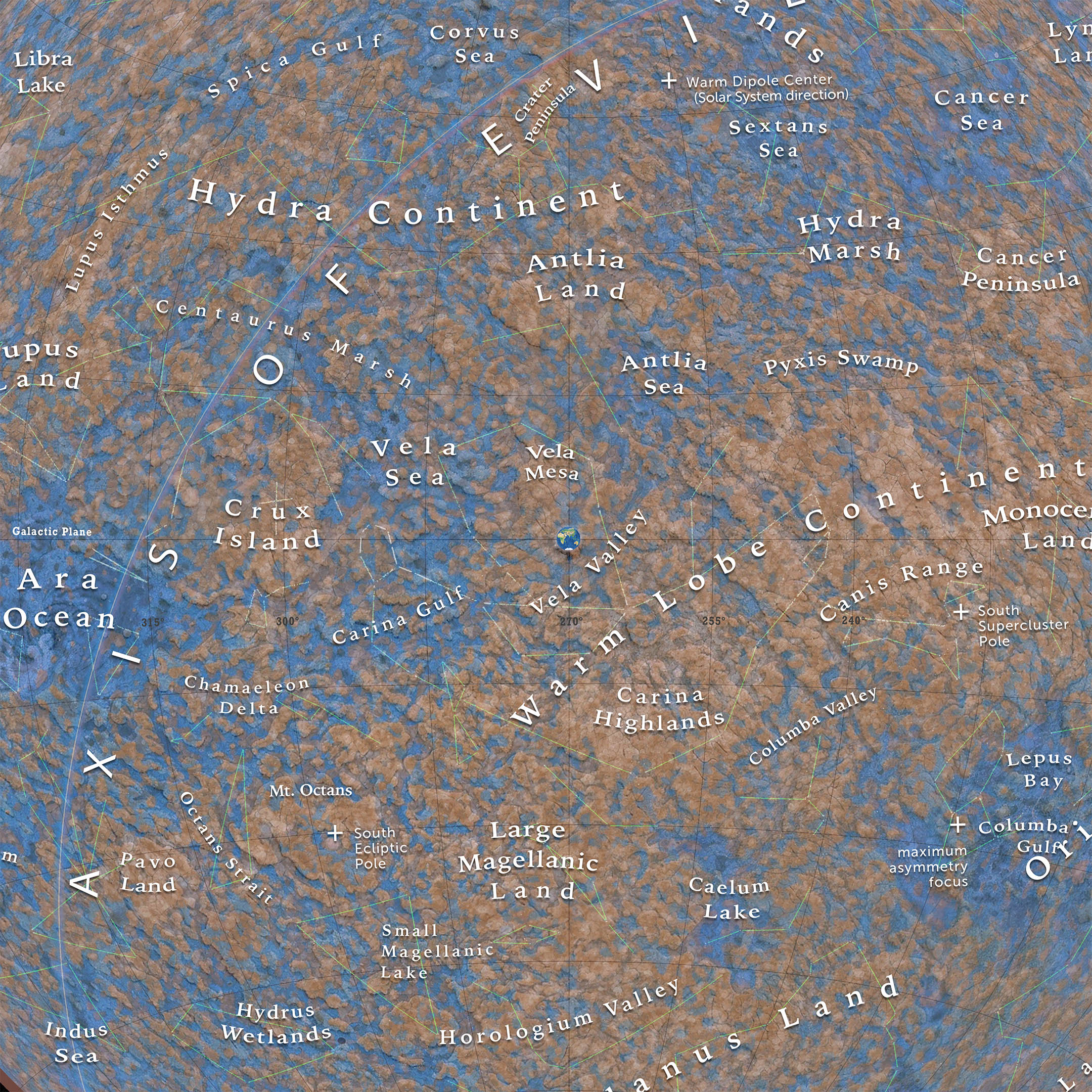 This zoomed-in view displays several specific regions using geographical nomenclature stolen from our mother planet. Labeled features include Draco Land, Cepheus Marsh, Cassiopeia Highlands, Andromeda Continent, along with the Cygnus, Pegasus, and Aquila Seas, and Hercules Land.
This zoomed-in view displays several specific regions using geographical nomenclature stolen from our mother planet. Labeled features include Draco Land, Cepheus Marsh, Cassiopeia Highlands, Andromeda Continent, along with the Cygnus, Pegasus, and Aquila Seas, and Hercules Land.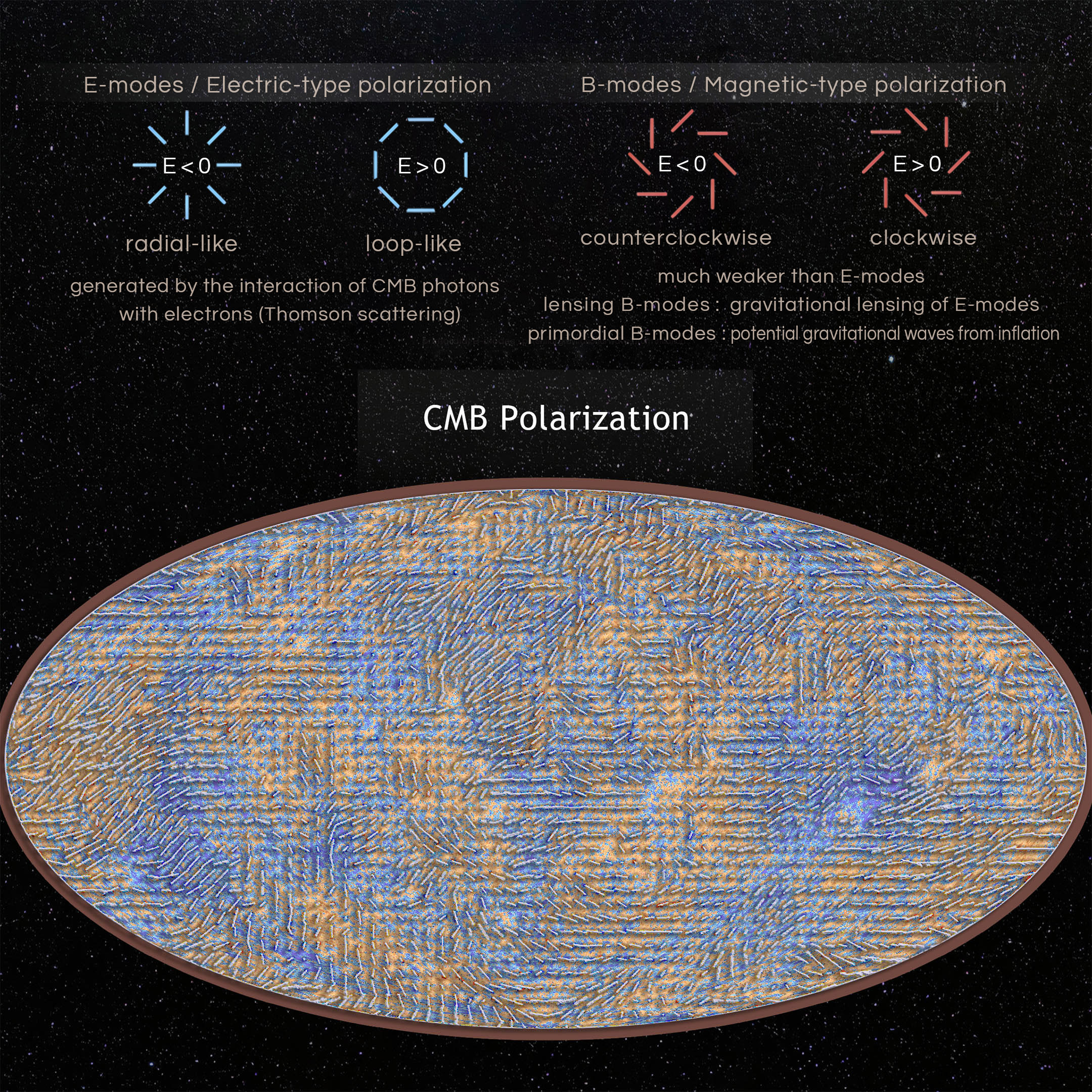 This Aitoff-projected inset map displays observed polarization patterns in the CMB. The patterns can be grouped into two types of polarization: E-modes, produced by Thomson scattering of CMB photons, and the weaker B-modes, which arise from gravitational lensing of E-modes or perhaps from primordial gravitational waves.
This Aitoff-projected inset map displays observed polarization patterns in the CMB. The patterns can be grouped into two types of polarization: E-modes, produced by Thomson scattering of CMB photons, and the weaker B-modes, which arise from gravitational lensing of E-modes or perhaps from primordial gravitational waves.
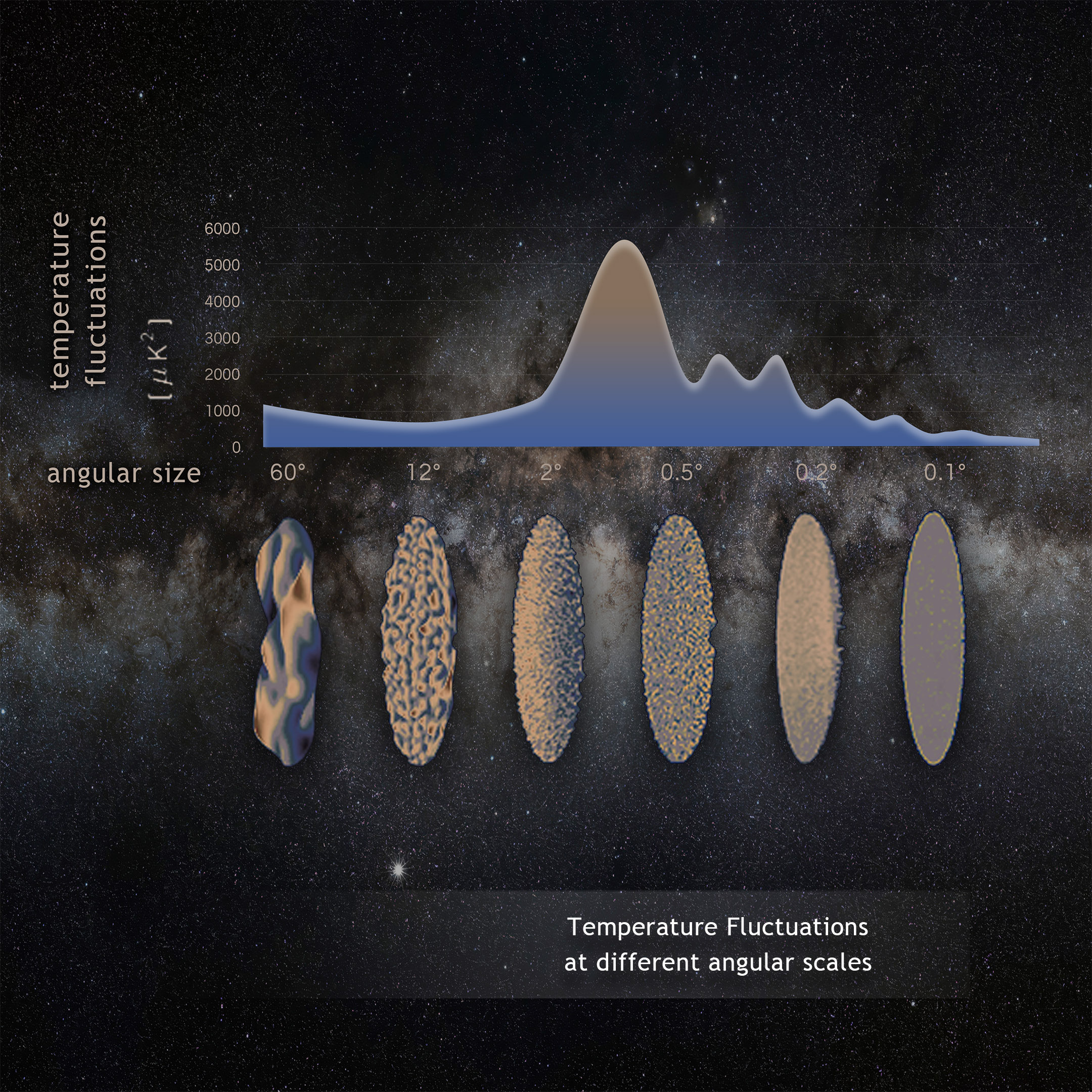 This apocriph chart illustrates how the temperature variations of the CMB change across different angular scales. It shows the amplitude of these fluctuations in microkelvin, with the 1-degree scale presenting the most prominent amplitude variation.
This apocriph chart illustrates how the temperature variations of the CMB change across different angular scales. It shows the amplitude of these fluctuations in microkelvin, with the 1-degree scale presenting the most prominent amplitude variation.
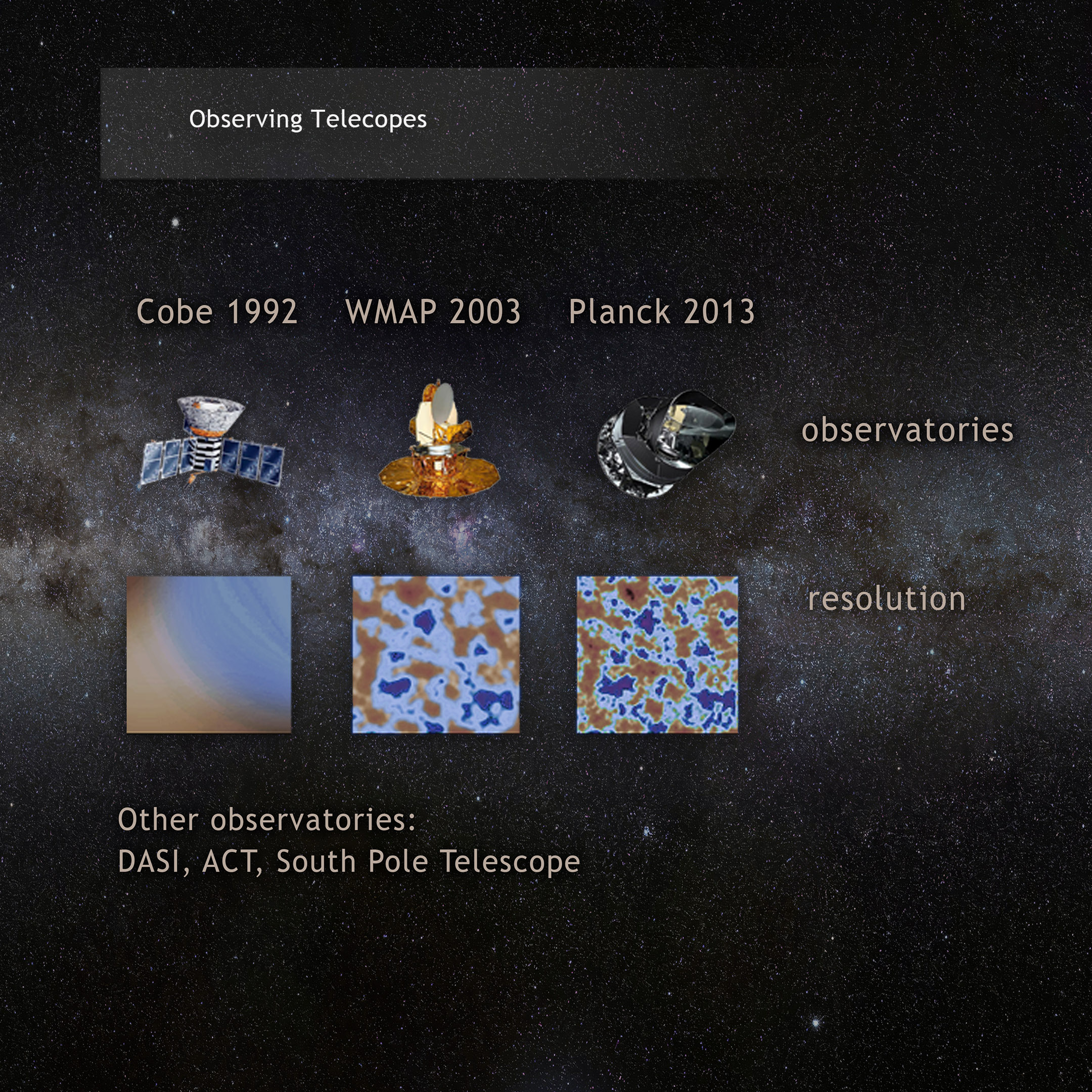 Space observatories have progressively enhanced our view of the early universe. The initial, lower-resolution map from COBE was surpassed first by WMAP, then by Planck. More recent contributions include data gained by Degree Angular Scale Interferometer (DASI), Atacama Cosmology Telescope (ACT), and the South Pole Telescope (SPT).
Space observatories have progressively enhanced our view of the early universe. The initial, lower-resolution map from COBE was surpassed first by WMAP, then by Planck. More recent contributions include data gained by Degree Angular Scale Interferometer (DASI), Atacama Cosmology Telescope (ACT), and the South Pole Telescope (SPT).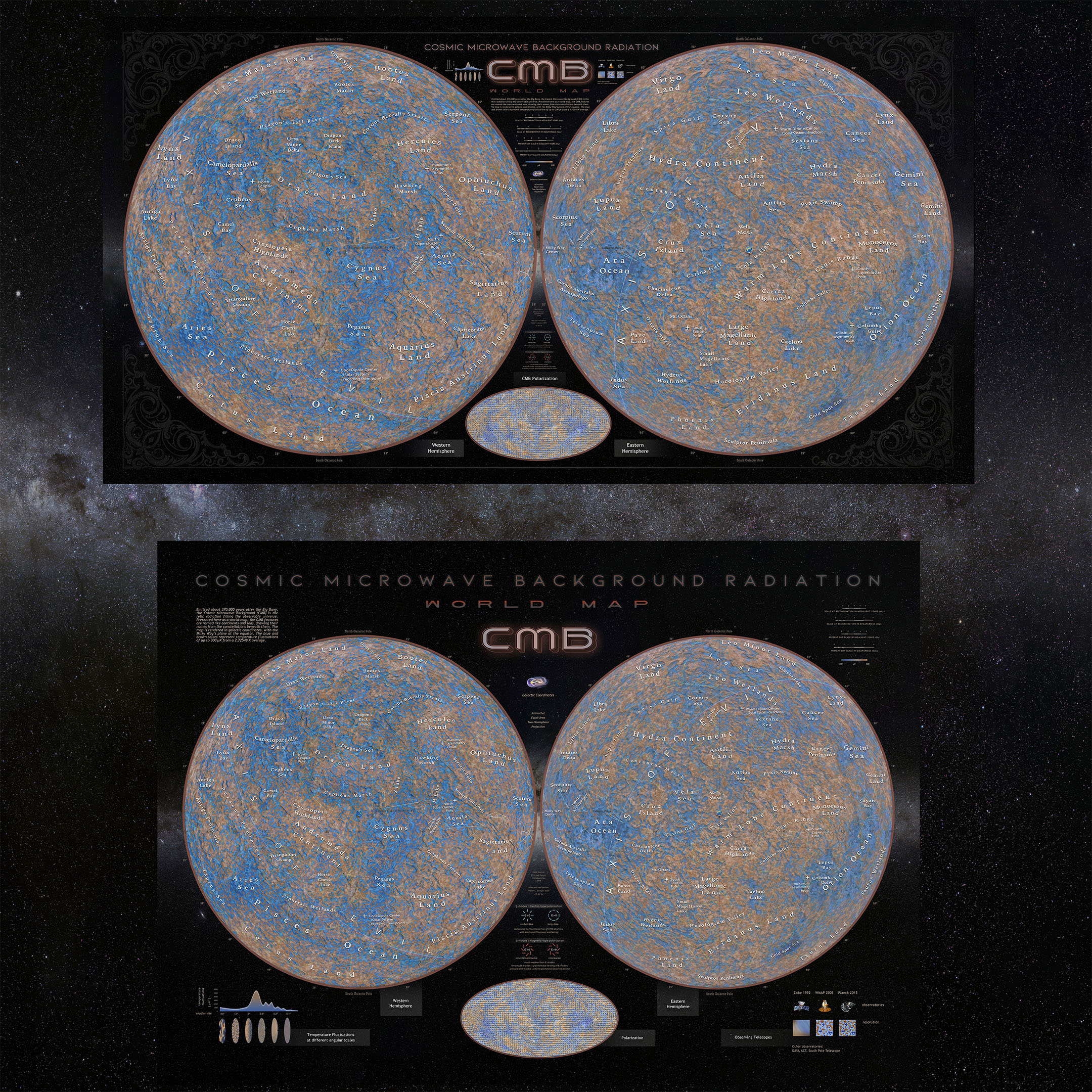
We crafted this entertaining map with genuine care and a clear vision. Imagine this planet the size of the space between the Sun and Aldebaran emerging from the plasma state. Not a solid surface, but a sphere of light whose slight fluctuations triggered the formation of colossal cosmic structures that define our universe for all eternity.
* Data credit ESA and Planck Collaboration. Map idea and realization Pablo C. Budassi in May 2025.
Fluctuations in the Cosmic Microwave Background
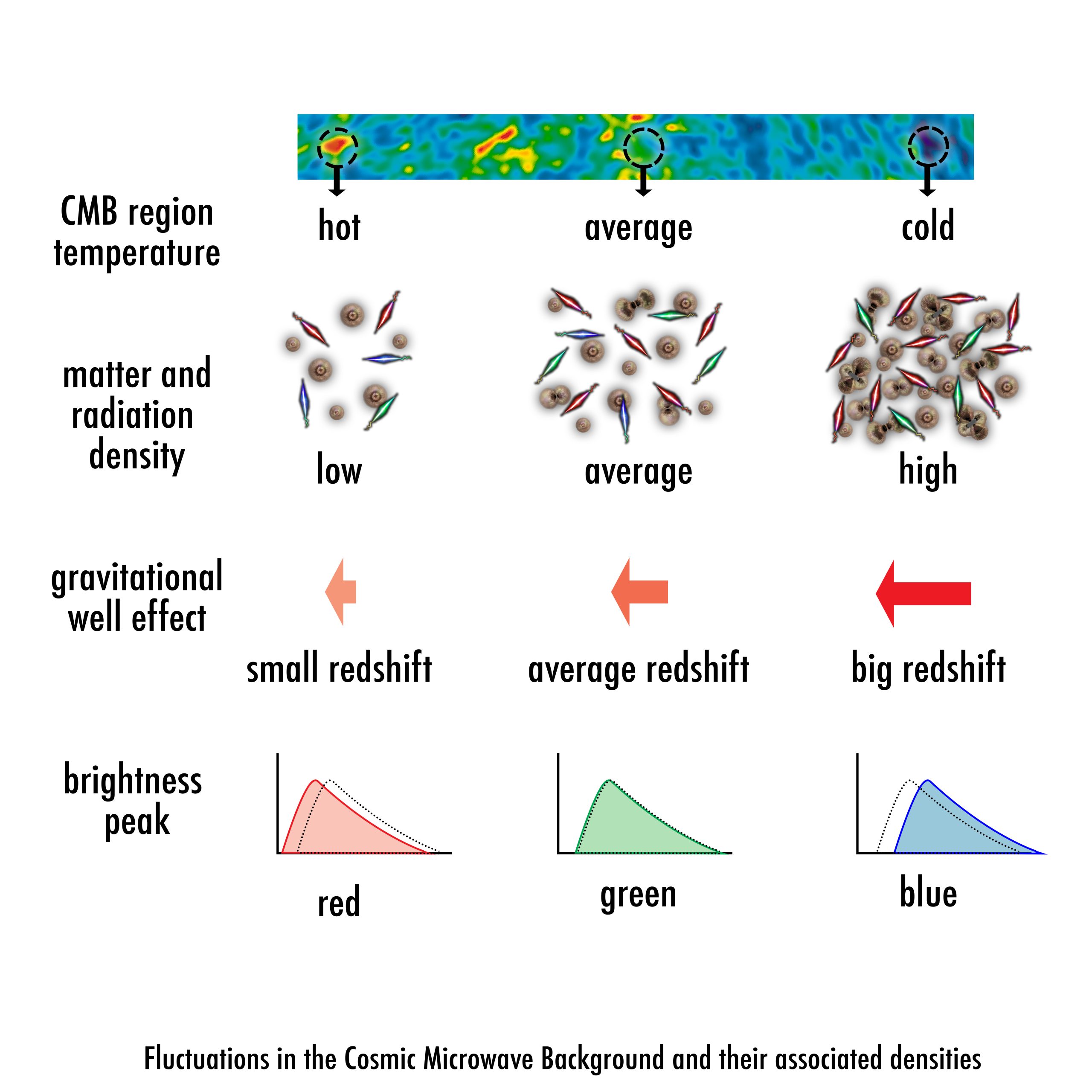 The cosmic microwave background is not perfectly uniform—its temperature varies by only a few millionths of a degree across the sky. These tiny fluctuations correspond to regions of slightly different density in the early universe. Hotter spots mark areas of lower density, while colder spots indicate higher density, where gravity was stronger and matter could begin to clump together.
The cosmic microwave background is not perfectly uniform—its temperature varies by only a few millionths of a degree across the sky. These tiny fluctuations correspond to regions of slightly different density in the early universe. Hotter spots mark areas of lower density, while colder spots indicate higher density, where gravity was stronger and matter could begin to clump together.
These variations also affect how light traveled through the early cosmos. Photons escaping from denser regions experienced a larger gravitational redshift, while those from less dense regions were shifted less. The result is a subtle pattern of color-coded peaks in brightness across the CMB spectrum. By studying these fluctuations, cosmologists can trace the seeds of galaxies and clusters, linking the faint ripples in the CMB to the large-scale structure of the universe we observe today.
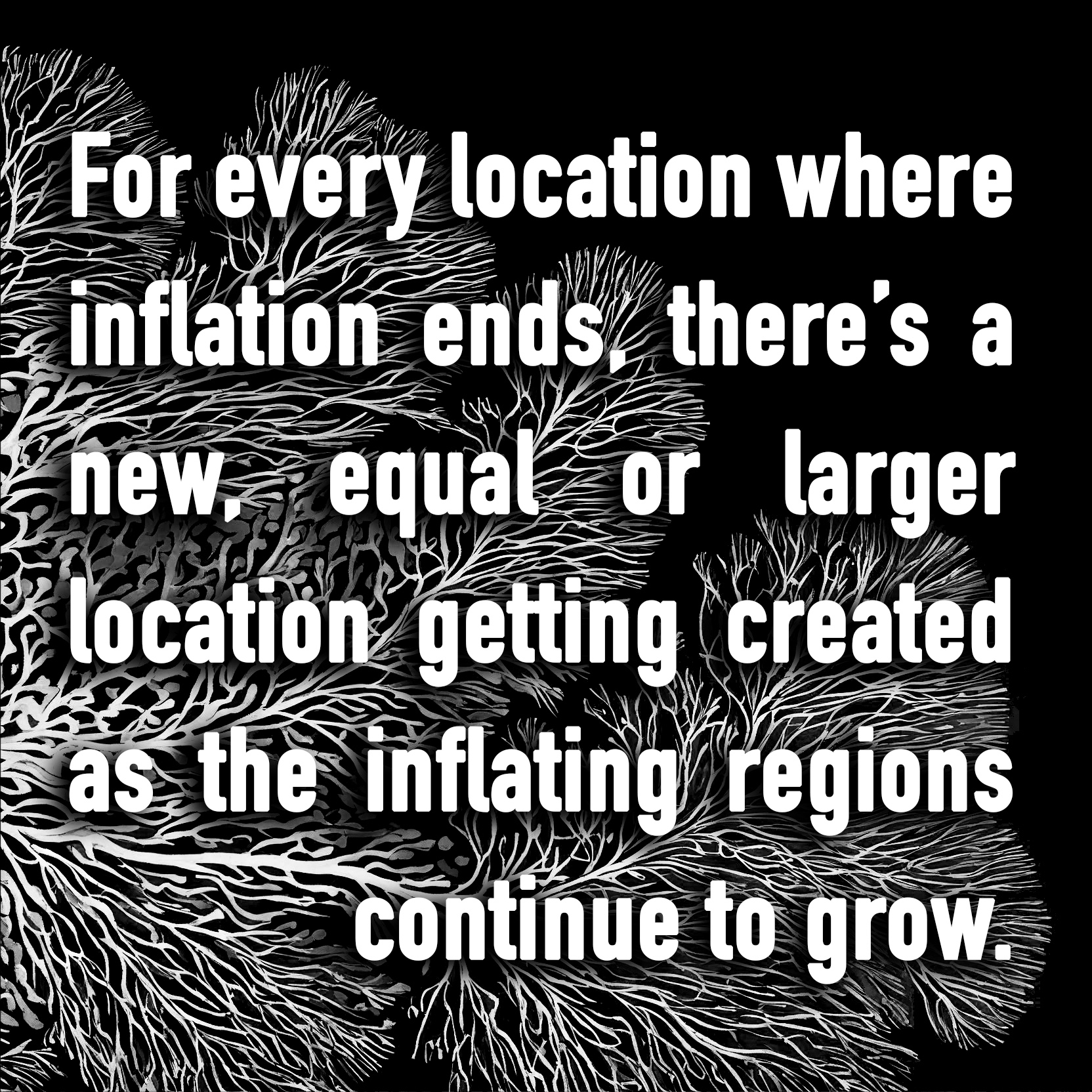 Cosmic inflation may not have been a one-time event. In many models, while inflation ends in some regions—creating “pocket universes” like our own—it continues elsewhere. As inflating regions expand faster than they decay, the overall volume of space still undergoing inflation keeps growing. This process is known as eternal inflation.
Cosmic inflation may not have been a one-time event. In many models, while inflation ends in some regions—creating “pocket universes” like our own—it continues elsewhere. As inflating regions expand faster than they decay, the overall volume of space still undergoing inflation keeps growing. This process is known as eternal inflation.The branching patterns in the illustration capture this idea: every time inflation ends in one location, new inflating regions appear and expand even more rapidly. The result is a self-replicating cosmic landscape, where countless regions could each evolve into their own universes with potentially different physical conditions. Our observable universe would then be just one small part of a much larger, ever-growing multiverse.

Inflation vs. Hot Big Bang
The universe’s history is often described as beginning with the “hot Big Bang,” but modern cosmology recognizes an even earlier stage: cosmic inflation. Inflation refers to a brief period of exponential expansion that occurred before the hot Big Bang, when space itself was filled with a uniform energy field. This phase smoothed out irregularities, flattened the geometry of the cosmos, and stretched tiny quantum fluctuations into the seeds of cosmic structure.
When inflation ended, its stored energy was released in a process called reheating, filling the universe with matter, antimatter, and radiation at extreme temperatures. This marks the start of the hot Big Bang, whose evidence we still observe today: the cosmic microwave background, the abundance of light elements, and the ongoing expansion of space.
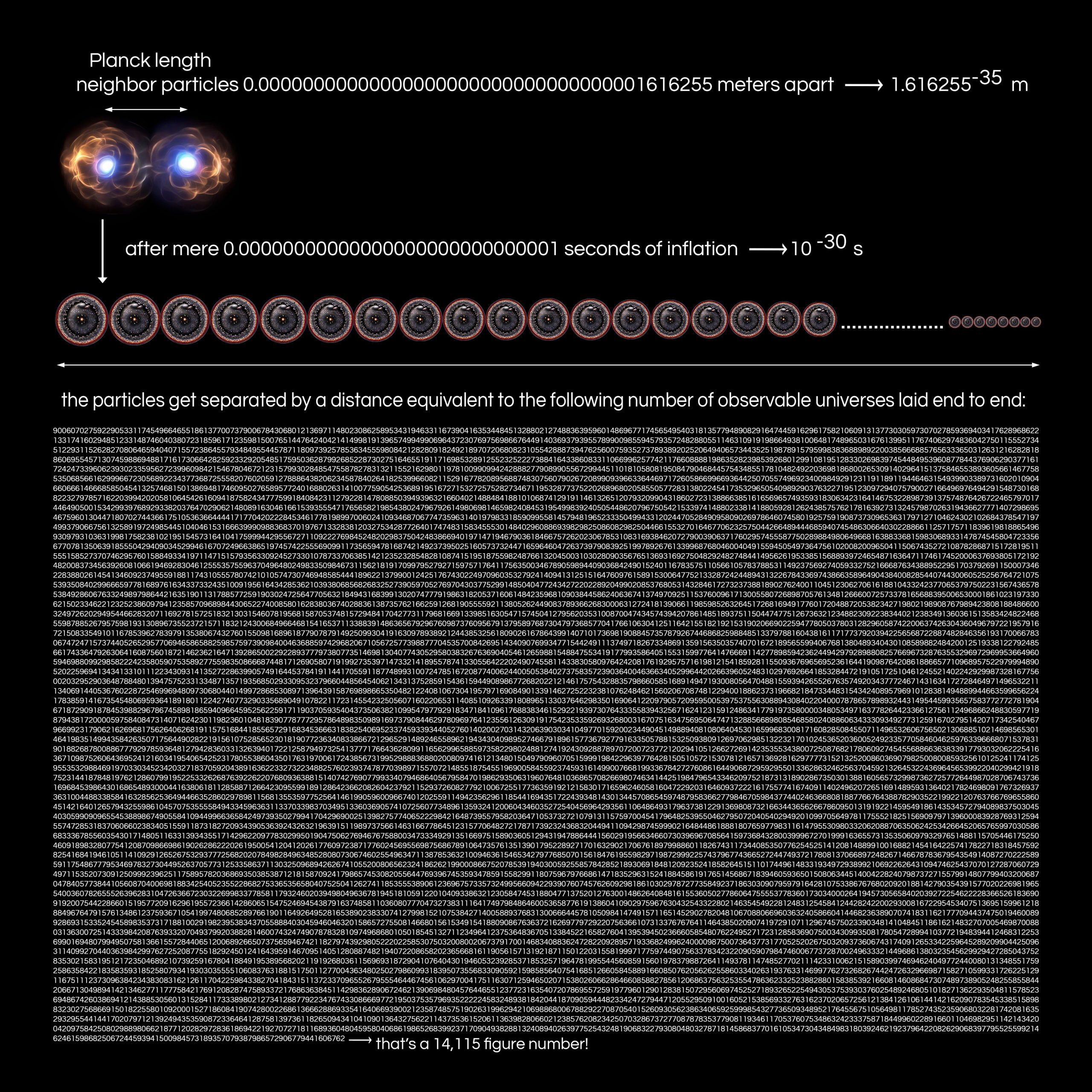 Cosmic inflation describes a period of extraordinarily rapid expansion in the earliest fraction of a second after the universe began. At the Planck scale, neighboring particles were separated by just 10^-35 meters—an unimaginably small distance. Yet in only about 10^-30 seconds, inflation stretched space so dramatically that those same points became separated by distances far larger than the size of our entire observable universe today.
Cosmic inflation describes a period of extraordinarily rapid expansion in the earliest fraction of a second after the universe began. At the Planck scale, neighboring particles were separated by just 10^-35 meters—an unimaginably small distance. Yet in only about 10^-30 seconds, inflation stretched space so dramatically that those same points became separated by distances far larger than the size of our entire observable universe today.
This extreme growth explains why the cosmos appears so uniform and flat on large scales, while still preserving the tiny quantum fluctuations that seeded galaxies. The comparison to thousands of observable universes laid end to end illustrates the sheer magnitude of this expansion, highlighting how inflation set the stage for everything that followed in cosmic history.
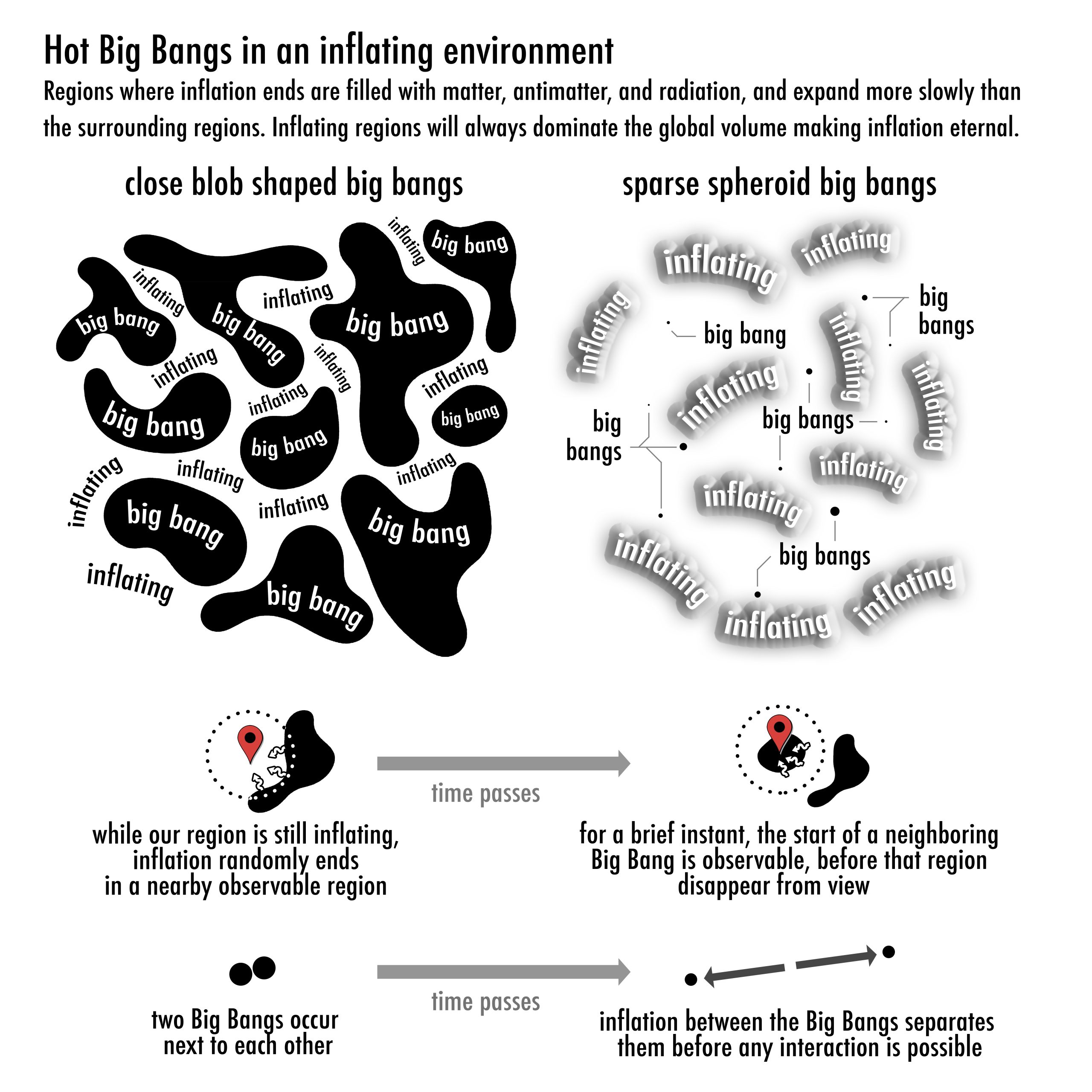
Hot Big Bangs in an Inflating Universe
In models of eternal inflation, the hot Big Bang is not a single, unique event but rather a local transition that can occur in many regions of space. As inflation ends in one area, it creates a “bubble universe” filled with hot matter and radiation. Meanwhile, inflation continues elsewhere, ensuring that new regions can undergo their own Big Bangs.
The illustration contrasts two possibilities: closely packed, irregular “blobs” of Big Bang regions versus more widely spaced, spherical ones. The difference reflects how inflation ends in different locations and how much separation exists between neighboring regions. In both cases, the inflating background grows faster than the Big Bang regions themselves, meaning the overall process never stops. This framework helps explain how our observable universe could be just one of many within a much larger inflating cosmos.
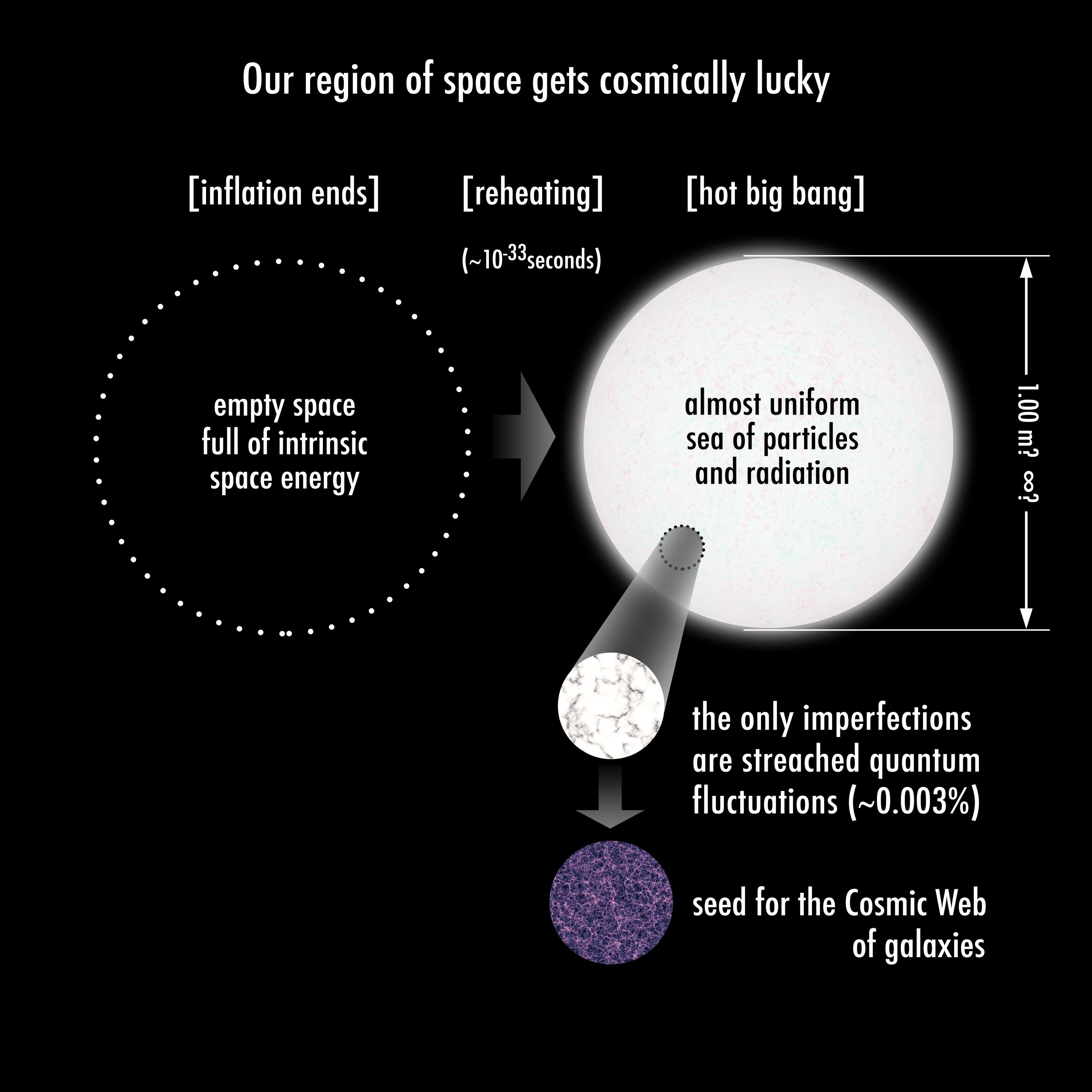
From Inflation to the Cosmic Web
After inflation ended, the universe transitioned into a nearly uniform sea of particles and radiation. The only imperfections were minuscule quantum fluctuations—differences in density of just a few thousandths of a percent. Though tiny, these variations were amplified over billions of years by gravity, eventually giving rise to the cosmic web: the vast network of galaxies and clusters we see today.
This process highlights how the largest structures in the universe trace their origins back to microscopic fluctuations in the earliest fractions of a second. The CMB provides a snapshot of this moment, preserving the imprint of those initial irregularities before stars and galaxies formed.
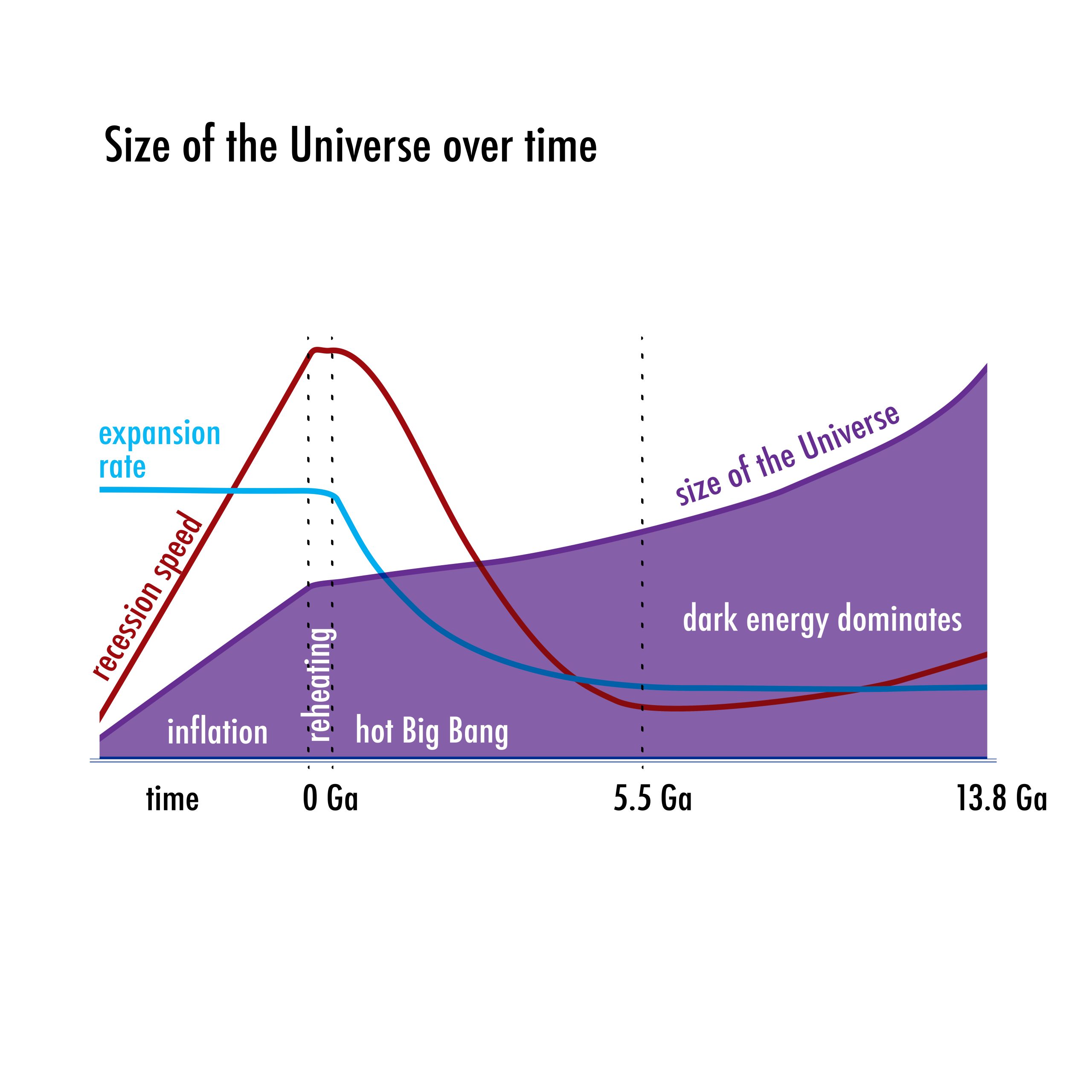
The Universe’s Expansion Over Time
The size of the universe has not grown at a steady pace—it has gone through distinct phases of expansion. During inflation, space expanded at an almost unimaginable rate, with both the expansion speed and recession velocity spiking briefly before dropping sharply as inflation ended. This transition released energy into matter and radiation, marking the start of the hot Big Bang.
For billions of years afterward, the expansion slowed as gravity from matter worked against it. Around 5.5 billion years ago, however, the influence of dark energy began to dominate, causing the expansion to accelerate again. Today, the universe continues to grow at an increasing rate, with dark energy shaping its long-term future. This timeline highlights how different physical processes—first inflation, then matter, and now dark energy—have each taken turns driving the evolution of cosmic expansion.
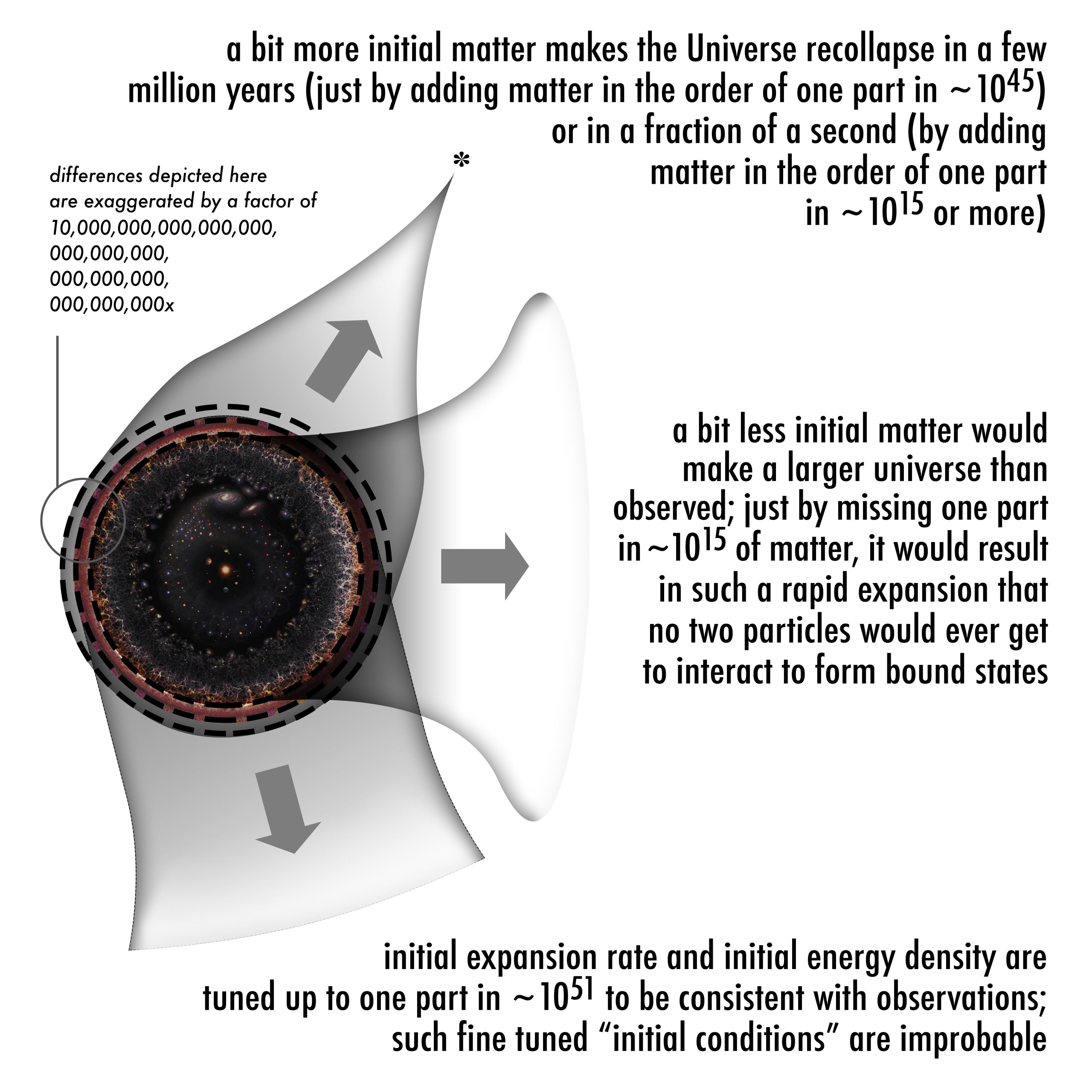
Fine-Tuning of the Early Universe
The evolution of the universe depended on an extraordinary balance between its initial matter content and its rate of expansion. If the universe had contained just a tiny fraction more matter—on the order of one part in 10⁴⁵—it would have collapsed back on itself within a few million years. With even larger deviations, collapse could have occurred almost instantly. Conversely, with slightly less matter, expansion would have been so rapid that particles would never have interacted to form stars, galaxies, or planets.
Observations show that the initial conditions were tuned with astonishing precision, to about one part in 10⁵¹. This fine balance allowed the universe to expand without collapsing, while still permitting matter to clump together under gravity. The result is a cosmos capable of forming the complex structures we observe today, from galaxies to life itself.
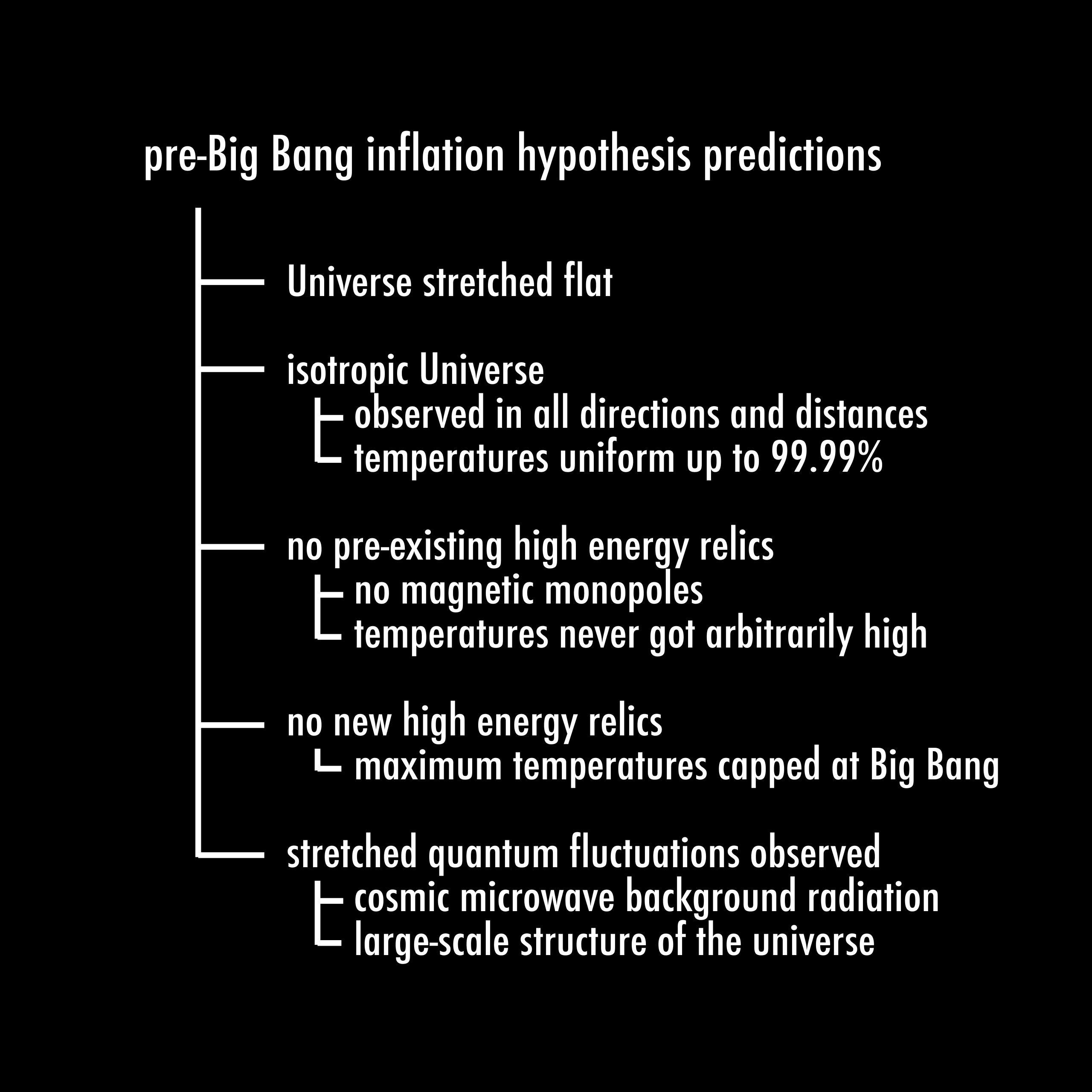
Predictions of the Inflationary Universe
The theory of cosmic inflation makes several testable predictions about the large-scale properties of the universe. It explains why space appears flat and why the cosmos looks nearly the same in every direction, with temperatures uniform to better than 99.99%. Inflation also predicts the absence of exotic high-energy relics, such as magnetic monopoles, since the maximum temperatures after inflation were capped at the Big Bang.
Perhaps most importantly, inflation stretched tiny quantum fluctuations to cosmic scales. These imprints are visible today in the cosmic microwave background and in the distribution of galaxies across the universe. The remarkable agreement between these predictions and observations has made inflation a central part of modern cosmology, even as researchers continue to refine its details.
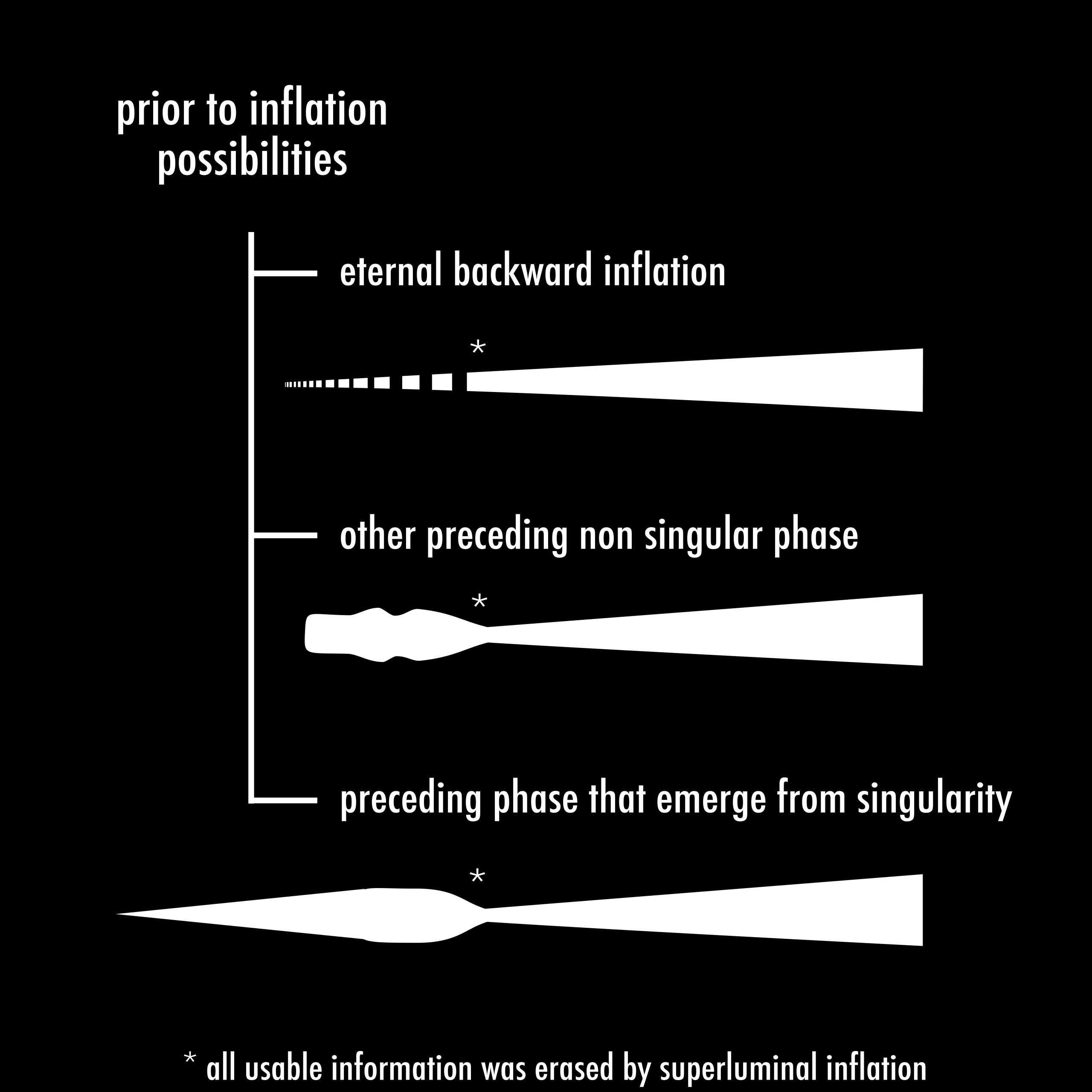
Possibilities Before Inflation
What came before inflation remains one of the deepest open questions in cosmology. Several theoretical possibilities have been proposed. In some models, inflation itself could extend infinitely into the past, erasing all prior information through its rapid expansion. Other scenarios suggest a non‑singular phase—perhaps a bouncing or cyclic universe—preceding inflation. A third possibility is that inflation emerged directly from a singular beginning, similar to the traditional Big Bang picture.
Although these ideas differ, they share a common feature: the details of any earlier state are hidden from observation. The superluminal expansion of inflation effectively “resets” the universe, leaving only the conditions at the end of inflation imprinted on the cosmos. This is why the cosmic microwave background provides our earliest reliable window into the universe’s history.

The Primeval Atom and Big Bang Predictions
Before the development of inflationary theory, the universe’s origin was often described in terms of a “primeval atom” or singularity—a dense, hot state from which everything expanded. While this picture is now considered incomplete, it led to several key predictions that remain central to modern cosmology.
From this framework, scientists expected the universe to be expanding, that distant galaxies would appear younger and less chemically enriched, that a faint background of leftover radiation should exist, and that light elements such as hydrogen and helium would be found throughout space. Each of these predictions has been confirmed by observation, providing strong evidence for the Big Bang model as the foundation of our understanding of cosmic history.
Possible Initial Shapes of Space:
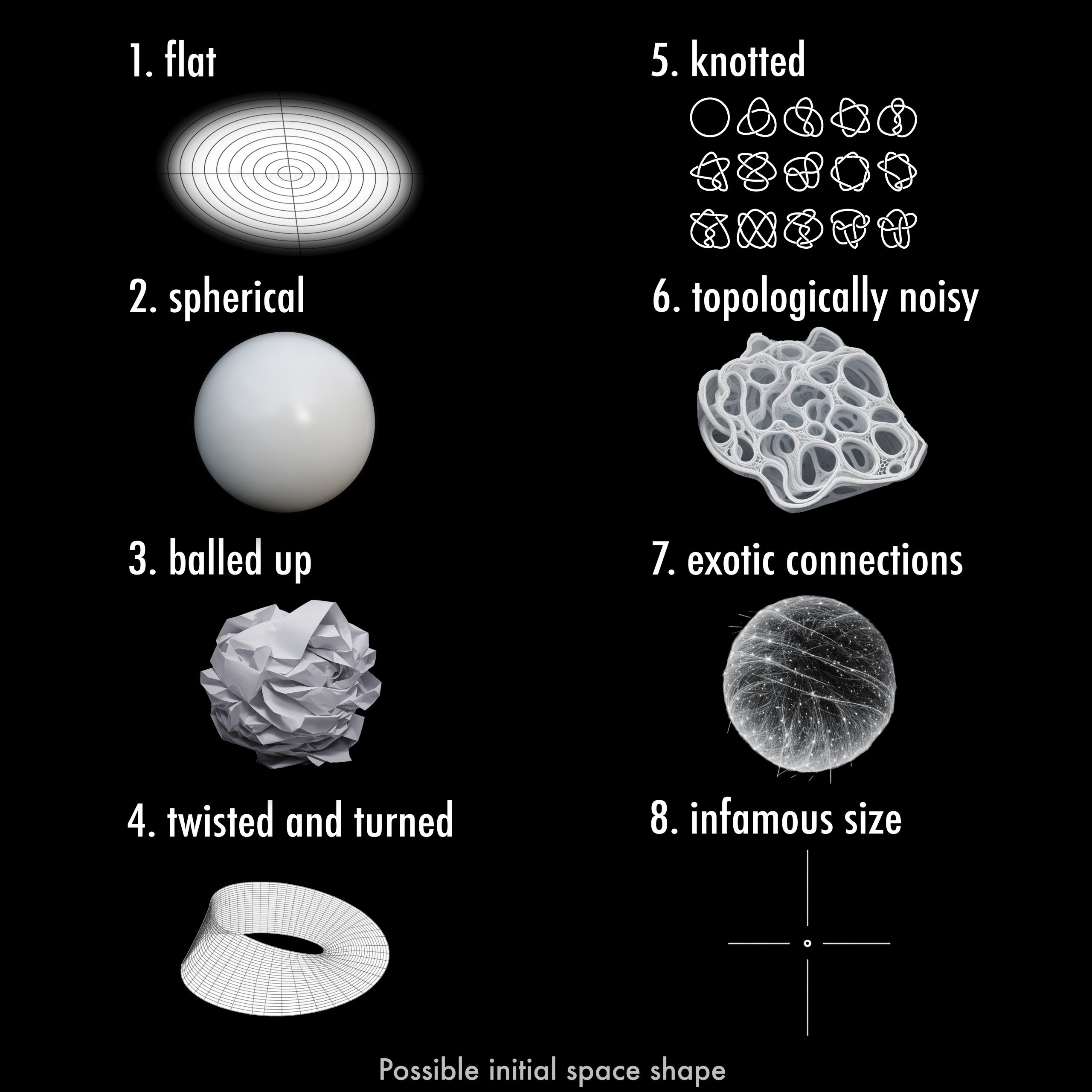
The ultimate origin of the universe may also depend on the geometry and topology of space itself. Theories of quantum gravity and cosmology allow for a wide range of possibilities: space could have been flat, spherical, knotted, twisted, or filled with exotic connections and irregularities. Each of these shapes represents a different way the fabric of space might have been configured at the very beginning.
While inflation tends to smooth out irregularities and drive the universe toward flatness, the question of the universe’s initial shape remains open. Exploring these possibilities helps physicists test the limits of current theories and consider how the earliest conditions might have influenced the large-scale structure we observe today.
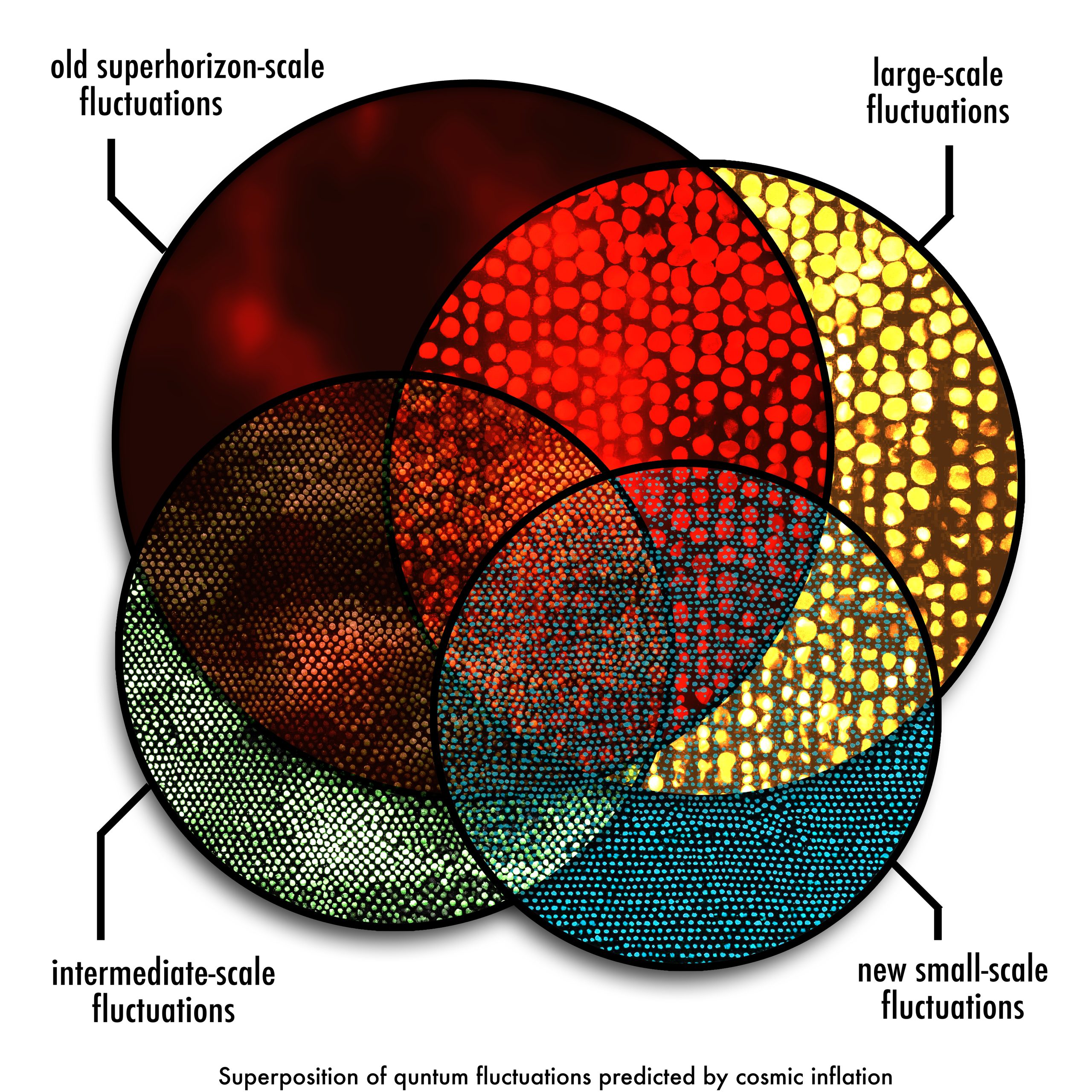 Superposition of Quantum Fluctuations
Superposition of Quantum Fluctuations
Inflation did more than expand space—it also stretched quantum fluctuations across a vast range of scales. Some of these fluctuations were so large they extended beyond the observable horizon, while others remained on intermediate or very small scales. All of them were layered together, creating a superposition of ripples in density and temperature.
This overlapping pattern is preserved in the cosmic microwave background, where we see the combined imprint of fluctuations from every scale. By analyzing these patterns, scientists can connect the tiniest quantum processes of the early universe to the largest cosmic structures we observe today. The CMB thus acts as a record of inflation’s imprint, carrying the signature of quantum fluctuations across the entire sky.
* The infographics on this page are free to reuse for any purpose. CC BY SA Idea and realization by Pablo Carlos Budassi / @thecelestialzoo

We crafted this entertaining map with genuine care and a clear vision. Imagine this planet the size of the space between the Sun and Aldebaran emerging from the plasma state. Not a solid surface, but a sphere of light whose slight fluctuations triggered the formation of colossal cosmic structures that define our universe for all eternity.
* Map: Data credit ESA and Planck Collaboration. Map idea and realization Pablo C. Budassi in May 2025.


